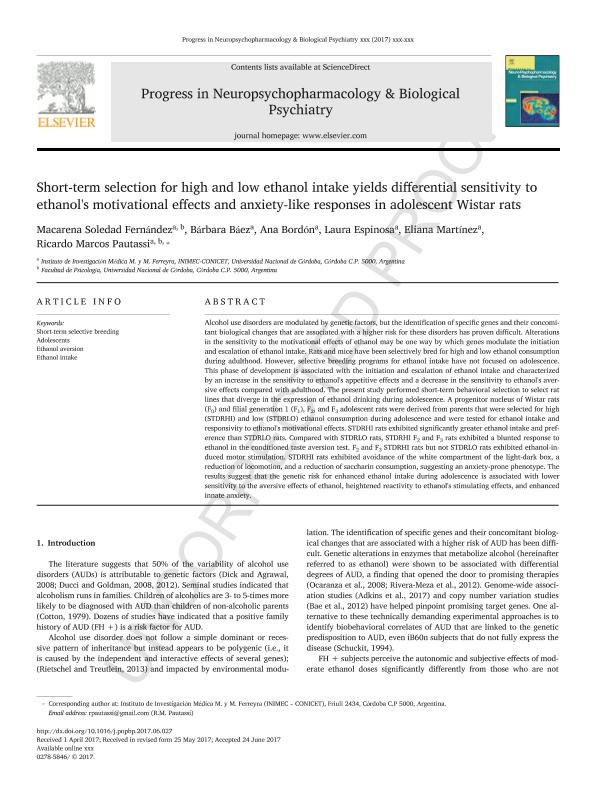Artículo
Short-term selection for high and low ethanol intake yields differential sensitivity to ethanol's motivational effects and anxiety-like responses in adolescent Wistar rats
Fernandez, Macarena Soledad ; Báez, Bárbara Beatriz
; Báez, Bárbara Beatriz ; Bordon, Ana; Espinosa, Silvana Laura
; Bordon, Ana; Espinosa, Silvana Laura ; Martinez, Eliana Soledad
; Martinez, Eliana Soledad ; Pautassi, Ricardo Marcos
; Pautassi, Ricardo Marcos
 ; Báez, Bárbara Beatriz
; Báez, Bárbara Beatriz ; Bordon, Ana; Espinosa, Silvana Laura
; Bordon, Ana; Espinosa, Silvana Laura ; Martinez, Eliana Soledad
; Martinez, Eliana Soledad ; Pautassi, Ricardo Marcos
; Pautassi, Ricardo Marcos
Fecha de publicación:
27/10/2017
Editorial:
Pergamon-Elsevier Science Ltd
Revista:
Progress of Neuro-psychopharmacology and Biological Psychiatry
ISSN:
0278-5846
Idioma:
Inglés
Tipo de recurso:
Artículo publicado
Clasificación temática:
Resumen
Alcohol use disorders are modulated by genetic factors, but the identification of specific genes and their concomitant biological changes that are associated with a higher risk for these disorders has proven difficult. Alterations in the sensitivity to the motivational effects of ethanol may be one way by which genes modulate the initiation and escalation of ethanol intake. Rats and mice have been selectively bred for high and low ethanol consumption during adulthood. However, selective breeding programs for ethanol intake have not focused on adolescence. This phase of development is associated with the initiation and escalation of ethanol intake and characterized by an increase in the sensitivity to ethanol's appetitive effects and a decrease in the sensitivity to ethanol's aversive effects compared with adulthood. The present study performed short-term behavioral selection to select rat lines that diverge in the expression of ethanol drinking during adolescence. A progenitor nucleus of Wistar rats (F0) and filial generation 1 (F1), F2, and F3 adolescent rats were derived from parents that were selected for high (STDRHI) and low (STDRLO) ethanol consumption during adolescence and were tested for ethanol intake and responsivity to ethanol's motivational effects. STDRHI rats exhibited significantly greater ethanol intake and preference than STDRLO rats. Compared with STDRLO rats, STDRHI F2 and F3 rats exhibited a blunted response to ethanol in the conditioned taste aversion test. F2 and F3 STDRHI rats but not STDRLO rats exhibited ethanol-induced motor stimulation. STDRHI rats exhibited avoidance of the white compartment of the light-dark box, a reduction of locomotion, and a reduction of saccharin consumption, suggesting an anxiety-prone phenotype. The results suggest that the genetic risk for enhanced ethanol intake during adolescence is associated with lower sensitivity to the aversive effects of ethanol, heightened reactivity to ethanol's stimulating effects, and enhanced innate anxiety.
Palabras clave:
Adolescents
,
Ethanol Aversion
,
Ethanol Intake
,
Short-Term Selective Breeding
Archivos asociados
Licencia
Identificadores
Colecciones
Articulos(INIMEC - CONICET)
Articulos de INSTITUTO DE INV. MEDICAS MERCEDES Y MARTIN FERREYRA
Articulos de INSTITUTO DE INV. MEDICAS MERCEDES Y MARTIN FERREYRA
Citación
Fernandez, Macarena Soledad; Báez, Bárbara Beatriz; Bordon, Ana; Espinosa, Silvana Laura; Martinez, Eliana Soledad; et al.; Short-term selection for high and low ethanol intake yields differential sensitivity to ethanol's motivational effects and anxiety-like responses in adolescent Wistar rats; Pergamon-Elsevier Science Ltd; Progress of Neuro-psychopharmacology and Biological Psychiatry; 79; 27-10-2017; 220-233
Compartir
Altmétricas



